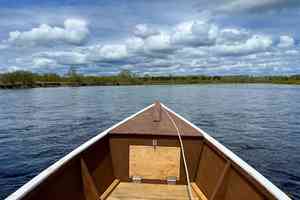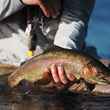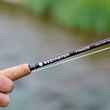As a fly fishing writer, as well as a fly fishing and casting instructor, one simple question seems to keep popping again and again.
“I want to buy one rod for my fly fishing. What’s the best overall trout rod?”
The standard response from long-time fly fishing industry members is actually pretty simple.
- Do a fair amount of research.
- Narrow down your choices based on your budget and your angling preferences.
- Visit your local fly shops and cast the models that seem like a good fit.
- Buy the rod you like the best.
While that particular piece of advice seems reasonable on its face, there’s one issue that makes it less than ideal. Before I spell out the problem, though, I’d ask you to consider my personal experience as a downhill skier.
Growing up, I skied a handful of times each year from the age of six or seven. As I got older, that pattern proved malleable. Sometimes I’d ski a couple of days a year, other times a week or two, and other times not at all. My peak as a skier probably came 25 years ago, when I had a season pass to Montana’s Bridger Bowl — we lived maybe 15 minutes away from the mountain at the time — and a friend, who was an extremely talented ski instructor, gave me a couple of free lessons that really improved my form.
At my very best, I was a solid intermediate skier. Looking back, though, I still relied on friends and industry pros to help me choose the best skis for my ability and budget.
More Like This
The years have passed, of course, and I no longer ski at all now that I’m in my 60s. If I headed for the slopes tomorrow, with skills that have rusted over the past couple decades, I’m not sure that I’d be able to ski well enough to enjoy myself — or to tell a good pair of skis from a mediocre pair.
Could I test a half dozen pairs of brand new skis and make an educated decision on which ones were best for me? To be frank, I tend to doubt it.
Which brings me back to the “visit your local fly shops and cast the rods that seem like the best fit” advice I shared earlier. That approach works great for folks who are accomplished casters. Solid fly casters — anglers who can throw nice tight loops with a 5 weight from 20’ out to 60’ — should be able to try a half dozen rods and choose the one they like the best with absolutely no problem.
Yet new anglers, or folks who’ve been fishing for a while but have never really developed their casting skills, aren’t going to have the requisite knowledge to make an educated choice. A fly fishing savant I know once noted: “Most people don’t cast well enough to judge the quality of a fly rod.” He was right, of course. Which points toward a pretty serious conundrum. If anglers lack the skills to differentiate between various rods, how do they know which one to buy?
That’s a tough question. While there’s a ton of marketing hype around fly rods, and a whole gaggle of folks who consider themselves experts, I’m not convinced that there are any great resources for new or intermediate anglers willing to spend their hard-earned cash on a high-quality fly rod.
Where does that leave us? Should less-experienced anglers trust fly rod manufacturers to steer them to the right rod? Should they trust fly shop employees or guides who may have a vested interest in promoting a particular model or brand? Should they rely on the outdoor media, or well-known fly fishing “experts,” or the folks they fish with? What’s the best way forward?
Here’s my advice for new anglers, or less-than-stellar casters looking to purchase a rod that will meet their needs for years to come.
- Set a budget and stick to it.
- Ask yourself how you feel about fly rods. Are they merely a tool to accomplish a task? Does a rod need to be aesthetically pleasing? Does function trump durability, or is durability more important than how a rod performs on the water? Are you more focused on casting, or protecting light tippets, or fighting a fish as quickly and effectively as possible? How vital is a good warranty?
You’ll also want to be honest with yourself. If you’re someone who puts a lot of emphasis on brands and labels, or who wants other anglers to admire your new rod, you should take that into account. If you don’t care what other folks think, that’s an important thing to know ahead of time. And it sure wouldn’t hurt to make a list of everything you want from your new rod before you pull out your credit card.
- Do as much research as possible, while keeping in mind that some people are better resources than others, and certain people will have an incentive to steer you in a particular direction. In other words, “caveat emptor.” Let the buyer beware.
All three of the points above, while helpful and important, are relatively standard. Now I’d like to wander off the beaten path and share some final advice you won’t hear every day.
If you’re a novice or intermediate angler, you should pay particular attention to how a company markets their fly rods. If they use terms like “fast” or “very fast” to describe a particular rod, that’s a red flag; a warning sign that the rod in question is probably not going to be a good fit for you.
For decades, rod manufacturers have claimed that faster (or stiffer) rods are better rods. While that may be true in certain specific situations, and for certain casters, it’s not an accurate claim overall. Fast rods don’t flex easily, and they require far more effort to cast. One of the finest casters I know — and a great angler as well — once summed things up in a Montana fly shop. He picked up a stiff rod, flexed it, shook his head in disappointment and declared, “No thanks. I like rods that bend.”
More recently, an incredibly skilled fly fisher I know made the same exact point:
“Most of the work done with the rod is the result of rotation and not flex. But flex is what makes a rod pleasant, or unpleasant, to cast.” He went on to add, “Most rods made today feel terrible.” Then he wrapped up with, “Humans are incredibly adaptable, and can make lousy rods work, which we’ve been doing for years. We can even con ourselves into believing bad rods are good. Many anglers have never cast a pleasant-feeling rod. If only they knew that.”
If only they knew …
At the end of the day, my advice is relatively simple. If you’re a novice or a less-than-stellar caster, and if you’re in the market for a new trout rod, you should set a budget, decide exactly what you want from your new rod, and then do as much research as possible.
I’d also suggest that you rule out every single fast action rod you run across. Stick to medium, or moderate, or medium-fast action rods; at least until you can cast well enough to make an educated decision on your own.
(As an aside, acclaimed fly fishing guide and instructor Brant Oswald suggests purchasing a rod that comes in well below your rod budget, then applying the money you just saved to fly casting lessons.)
At the end of the day, of course, there’s one final question to consider. We know that trout anglers have purchased thousands and thousands of fast action fly rods over the last 30 years. Are they useless? Should we re-purpose them as ski poles or wading staffs? Should we put them in storage or give them to the very best casters we know? What should happen to all those overly-stiff rods?
My suggestion is actually pretty simple. Rather than moth-balling those rods, the folks who own them should try going up a line size with their fly line. A couple of my favorite 5 weights are actually fast action 4 weights that I fish with a one-size-heavier line. It won’t work for every rod — some models are truly beyond redemption — but utilizing a heavier line can indeed help certain fast action rods perform far better on the water.































Comments
Tim Sullivan replied on Permalink
The following statement isn't clear to me...
"A couple of my favorite 5 weights are actually fast action 4 weights that I fish with a one-size-heavier line."
Does that mean that you have up-sized to a 6 wgt line for those 5 wgt rods or that, because they are actually 4 wgt rods, you are using 5 wgt lines on them?
Todd Tanner replied on Permalink
Hi Tim,
I have a couple of fast action 9' 4 weight fly rods that didn't cast, or fish, particularly well with 4 weight lines. When I over-lined those rods using 5 weight lines, they not only performed far better on the water but were much more fun to cast.
To my mind, those rods are actually 5 weights that were mis-labeled by the manufacturers. But if you go by the information printed on the rod, they're 4 weights.
Not every fast 4 weight will perform better with a 5 weight line -- but some of them certainly do.
Fritz replied on Permalink
It is my experience that while rods may be "designed" and designated for a specific weight line, rods can handle one or more weight lines. I have purchased lines by Rio that are weighted in + increments, e.g. 4+, 5+, etc. Suggest to try other line weights to determine what is best for you.
Fritz replied on Permalink
Just one additional comment: while others may disagree, rod balance also is important especially when high sticking all day. I know of several who have been diagnosed with muscle and shoulder problems because of tip heavy rods being compensated with the wrist.
Don Andersen replied on Permalink
And if you weighted the lines, you will probably find that the 5 weight is really a 6 or maybe a 7 weight although marked on the box as a 5 weight.
Rio had only 2 lines in their stable that were true to line weight till recently.
Sci. An, had more and Cortland even more however upwards of 50 % were mislabelled.
Geoff Roznak replied on Permalink
This is why I always find out the grain weight of a line before I buy.
Geoff Roznak replied on Permalink
I wish that rod manufacturers would put the grain weight window right on the rods in addition to the nominal rod weight rating.
It's save us a lot of time and money.
Kevin harris replied on Permalink
I had a nice 8 wt loomis gxi1rod that worked very well on smaller fish. Hooked
a 3 lb trout snd the ferral split wide open
No warranty on their rods. Make sure any rod you choose has warranty for the unexpected.
Jim Leslie replied on Permalink
That's good advice. The first rod I purchased was in 1989. The shop owner put a Sage & a Winston in my hands. In those days, 9' 6 wt was the go-to tool for the Snake River in Wyoming. The slower action Winston performed much better in my inexperienced hands than the Sage. Back then, Sage had two models: fast and faster. The Winston suited my personality back then and still does to this day. Ordering from the Internet is risky, in my opinion. Thankfully, I had a good experience buying a low-priced Winston rod made in Japan that turned out to be a keeper.
Geoff Roznak replied on Permalink
Good article.
A couple of thoughts:
1) Make sure the shop you buy from has people who are good at the kind of fishing you do. For example, I'm not much of a trout angler, preferring to cast flies at musky, pike, or bass. It'd be a bad idea for me to buy a rod from a trout focused shop, if I didn't have a very good idea what I was looking for.
2) It's not the worst idea in the world to test cast a very good rod in the rod weight range you are looking for...one of the industry leaders, even if you can't afford it (or won't spend that much, same thing). That way you'll learn what is possible, and you'll be able to make more knowledgeable choices about what characteristics of the rod you buy are important to you.
I would not have know what was possible until I cast a rod that rhymes with "belios" in an 8 wt. Or what a real musky fly rod felt like, rather than all the re-purposed salt water rods out there, if I hadn't tested a Chippewa River Predator rod.
The experiences taught me much, and refined what I knew.
STEVE JESUS replied on Permalink
This article can be applied to any new endeavor or hobby, cameras, golf clubs, darts, bikes, shooting, you name it. You just have to go through the expensive learning process until you know something about what you're doing. Part of the excitement of learning a new skill.
Mike in Missouri replied on Permalink
The best advice I would give to someone is, Go with a guide and fish what he has. Don't pay attention to the brands, have fun and make your decision after a trip or two. Note: not every brand will be your favorite for every weight of line your casting . My favorite rod in Alaska for Salmon is not my favorite brand in Southern Missouri or Arkansas for trout .
Bolderado replied on Permalink
Hi Todd, nice article and I appreciate your thoughts! I agree with you regarding the "fast rod" craze. IMHO the fit for these rods are big flies, big winds or both! I would add my slower dry fly rods are useless casting sInking lines. The only fast rods I own are my saltwater rods, big flies and often big winds! But I also discovered that with a reel change I can throw big articulated streamers with a sinking like using my 7wt salt rod. My touch rods are for dry flies, nymphs and smaller streamers like leeches and they work great for that. When I'm advising a newbie on a rod purchase I always ask them what type of fishing they prefer(dry, nymph, streamers), where they like to fish, big rivers, small streams, still water or salt water and the species they plan to target. If they plan to cast a heavy double streamer rig, they may just want to purchase a cannon.
Fritz replied on Permalink
In my opinion, another overlooked aspect of rod selection is balance. When choosing a rod, especially a long rod, it's not a bad idea to attach the loaded reel to it as well. An overly unbalanced heavy tipped rod can cause muscle fatigue and shoulder problems. This is particularly true when high sticking for long periods. Tight lines
Louis Grenier replied on Permalink
It's funny how I fell on this article while I'm currently shoping for a all around 5 weight rod. I was looking at the Loop Opti K2 which can come in med-fast or fast action are I'm teared up on what to choose. I've been fly fishing for the last three years and I would say I'm an intermediate caster. Still hesitating but this article should lead me toward med-fast.
Don Andersen replied on Permalink
Guys,
It is tough for a begineer to know what he/she is getting when both the lines and rods are mislabelled.
This crap has been going on for 25 or more years.
'bout time it stops.
Don
Ian Rawlings replied on Permalink
Couldn't agree more about slower action rods. I generally don't like fast action graphite/carbon rods as they are like fishing with a broomstick. I especially don't like the way they tear bait off your hook while casting. I have been looking for a slower action fly rod, but just can't find one that I can afford. Everything is marketed as fast action as though that's the be all and end all of rod quality. Just too hard to learn to fly cast with those things. I ended up overlining the 8 wt saltwater rod I had purchased (yeah, I learnt the hard way) and that helped. But I needed to go way over the rod's stated line weight to 9 and even 10 wt fly lines. Buying extra fly lines gets expensive! Not sure that a fibreglass rod might not be okay, but hard/impossible to find.
Doug replied on Permalink
One word. Fiberglass.
Pages